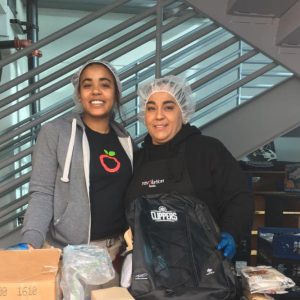Hybrid Learning at Green Dot Public Schools

Transforming Public Education in Underserved Communities in Tennessee
We all know that this has been a year like no other. The traditional brick-and-mortar of physical schools was replaced with online learning from home. But as millions of students, teachers and parents adjusted to school closures and virtual classrooms, it became even more obvious that access to reliable technology is starkly divided along socio-economic lines. While laptops and broadband service have – in theory – become essential services, in practice this is not always the case.
For the staff at Green Dot schools, these disparities are simply unacceptable.
Green Dot Public Schools work with families and communities in historically underserved communities to demand better school options for their students. They serve students who may fall through the cracks in the traditional school system – both in terms of academic preparation and the need for academic acceleration. Their mission: transform public education so all students graduate prepared for college, leadership, and life.
Big Things Start Small
In August 2000, Green Dot opened its doors with just one 9th grade class. Over the next five years, five start-up independent charter high schools were opened in some of the toughest neighborhoods in Los Angeles. All five went on to be named in Newsweek’s annual ranking of the best high schools in the United Sates and were medal winners in the annual U.S. News and World Report list, placing them in the top 2.5% nationally. Today, Green Dot serves over 14,000 students in some of the most poverty-stricken communities across California, Texas, and Tennessee.
 COVID-19
COVID-19
The COVID-19 pandemic created severe unemployment in already low-income communities that struggle to secure basic necessities. Most Green Dot families navigate continual challenges connected to poverty, and many students had to take jobs to supplement family income or care for younger siblings while their parents worked several jobs to make ends meet.
Green Dot responded quickly. With financing from ‘Quiet Cove Foundation Fund at Myriad Canada’, over 2,000 Chromebooks were purchased and distributed to Green Dot students at all five schools in Memphis. Wifi hotspots were distributed free to families lacking Internet connectivity. With nearly 100% of students relying on receiving both breakfast and lunch at school, students were now at risk of facing real food insecurity. Green Dot provided meals to any family that needed them, making available a full week’s worth of breakfast and lunch to be picked up at school sites once a week, with staff personally delivering food boxes to families without transportation.
Difficult Choices

“I chose to come back to school to have the motivation and the push from my teachers. I feel that with everything going on I am very grateful to come into school because they are able to push me and make me want to do more. They enable me to reach to my goals.”
— Ninth Grade Student
In spite of these measures, when families have to choose between rent and electricity, a student may go weeks without access to the Internet – and school.
For those most vulnerable and at-risk students, a seat in an actual classroom is critical. Green Dot created a ‘hybrid’ school re-entry plan to address this need, contacting families of chronically absent students to encourage a return to campus, working with parents to address barriers to returning to live instruction and connecting families with appropriate resources to assist with school attendance, including providing transportation to every student who needs it. Each month, families choose whether their student will come to school or learn from home.
In January 2021, 546 students, 23% of the Green Dot student population in Memphis, returned to classrooms. Each classroom now has two projectors: one that projects course materials from the teacher’s laptop; and one that displays the images of at-home students in the classroom to encourage a greater sense of community and engagement and to support the peer-to-peer learning that has been so difficult to achieve in a purely remote setting.
Helping to Bridge the Many Divides

“The reason I stopped going to virtual school and started coming in-class was because I wasn’t ‘getting it’ online. And I was so determined to come to school that I ride my bike a very long way every day all the way to Hillcrest High School.”
— Tenth Grade Student
Providing Chromebooks and LCD projectors was crucial in bringing at-home students into the classroom with their peers, helping close the ‘digital divide’. Yet as the push to reopen schools to support ‘hybrid’ learning became paramount, concerns regarding the neighborhoods in which the students live made carrying laptops between school and home a significant safety issue. To support the hybrid learning model, Green Dot will require an additional inventory of computers.
Returning to classrooms has boosted social and emotional well-being for teachers and students. After a full year of peering through computer screens only, Green Dot educators and students are once again sitting in a “real” classroom — able to interact with one another. Simple things that once taken for granted are appreciated far more deeply than ever before.
Douglas Weston, Vice-President of Green Dot Public Schools, has this message for Canadians: “Although we are not in a room together, or even at times in the same state or country, we are profoundly grateful for our partners near and far who make this work possible through their generosity and vision. Thank you.”

